Benedicts solution Study guides, Revision notes & Summaries
Looking for the best study guides, study notes and summaries about Benedicts solution? On this page you'll find 71 study documents about Benedicts solution.
Page 3 out of 71 results
Sort by
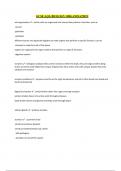
-
GCSE AQA BIOLOGY ORGANISATION
- Exam (elaborations) • 6 pages • 2024
- Available in package deal
-
- £8.08
- + learn more
GCSE AQA BIOLOGY ORGANISATION cell organisation ️similar cells are organised into tissues that perform a function, such as: -muscle -glandular -epithelial different tissues are organised together to make organs that perform a specific function, such as -stomach is made from all of the above organs are organised into organ systems that perform a range of functions -digestive system enzymes ️biological catalysts that control reactions within the body. they are large proteins (long ch...
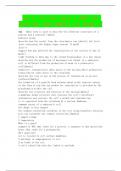
-
aqa as biology paper 2 2022 ALL SOLUTION 100% CORRECT AID GRADE A+
- Other • 3 pages • 2023
-
- £9.94
- + learn more
AQQ 1what term is used to describe the different structures of a glucose and b glucose? [1mark] hydroxyl group describe how the result from the colorimeter can identify the fruit juice containing the higher sugar content [1 mark] juice b suggest how pna affected the transcription of the section of dna [2 marks] tight binding to mrna due to the strand displacement in a dna target describe how the production of messenger rna (mrna) in a eukaryote cell is different from the production of mrna...
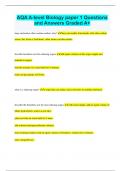
-
AQA A-level Biology paper 1 Questions and Answers Graded A+
- Exam (elaborations) • 33 pages • 2024
- Available in package deal
-
- £8.08
- + learn more
large molecules often contain carbon. why? they can readily form bonds with other carbon atoms. this forms a 'backbone'. other atoms can then attach. describe benedicts test for reducing sugars add equal volumes of the sugar sample and benedicts reagent. heat the mixture in a water bath for 5 minutes. brick red precipitate will form. what is a reducing sugar? a sugar that can reduce (give electrons to) another chemical. describe the benedicts test for non reducing sugars with food sampl...
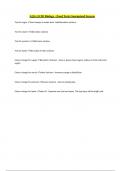
-
AQA GCSE Biology - Food Tests Guaranteed Success
- Exam (elaborations) • 1 pages • 2024
- Available in package deal
-
- £8.08
- + learn more
AQA GCSE Biology - Food Tests Guaranteed Success Test for sugar Food sample in water bath. Add Benedicts solution. Test for starch Add iodine solution Test for proteins Add biuret solution Test for lipids Add sudan III stain solution Colour change for sugars Benedict's Solution - blue or green (least sugar), yellow or brick-red (most sugar) Colour change for starch Iodine Solution - browny-orange to black/blue Colour change for proteins Biruets Solution - blue to pink/purple C...
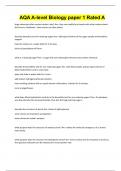
-
AQA A-level Biology paper 1
- Exam (elaborations) • 20 pages • 2023
- Available in package deal
-
- £7.59
- + learn more
AQA A-level Biology paper 1 Rated A large molecules often contain carbon. why? Ans- they can readily form bonds with other carbon atoms. this forms a 'backbone'. other atoms can then attach. describe benedicts test for reducing sugars Ans- add equal volumes of the sugar sample and benedicts reagent. heat the mixture in a water bath for 5 minutes. brick red precipitate will form. what is a reducing sugar? Ans- a sugar that can reduce (give electrons to) another chemical. describe the ...
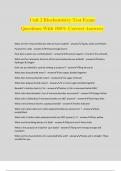
-
Unit 2 Biochemistry Test Exam Questions With 100% Correct Answers
- Exam (elaborations) • 3 pages • 2024
- Available in package deal
-
- £8.48
- + learn more
Unit 2 Biochemistry Test Exam Questions With 100% Correct Answers What are the 3 macromolecules that we have studied? - answerLipids, Carbs and Protein Purpose for carbs - answerPrimary Energy Source How does a plant use a carbohydrate? - answerStructural support - Found in the cell walls What are the 3 elements found in all the macromolecules we studied? - answerCarbon, Hydrogen & Oxygen How can you identify a carb by looking at a picture? - answerRing Structure What does disaccharide m...
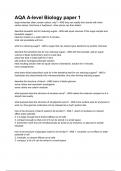
-
AQA A-level Biology paper 1
- Exam (elaborations) • 15 pages • 2024
-
- £6.86
- + learn more
AQA A-level Biology paper 1 large molecules often contain carbon. why? - ANS they can readily form bonds with other carbon atoms. this forms a 'backbone'. other atoms can then attach. describe benedicts test for reducing sugars - ANS add equal volumes of the sugar sample and benedicts reagent. heat the mixture in a water bath for 5 minutes. brick red precipitate will form. what is a reducing sugar? - ANS a sugar that can reduce (give electrons to) another chemical. describe the ben...
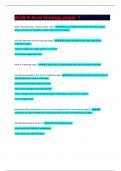
-
AQA A-level Biology paper 1
- Exam (elaborations) • 23 pages • 2024
- Available in package deal
-
- £9.70
- + learn more
large molecules often contain carbon. why? - they can readily form bonds with other carbon atoms. this forms a 'backbone'. other atoms can then attach. describe benedicts test for reducing sugars - add equal volumes of the sugar sample and benedicts reagent. heat the mixture in a water bath for 5 minutes. brick red precipitate will form. what is a reducing sugar? - a sugar that can reduce (give electrons to) another chemical. describe the benedicts test for non reducing sugars - with fo...
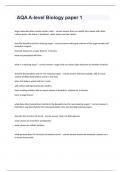
-
AQA A-level Biology paper 1 Question With 100%Varified Answers.
- Exam (elaborations) • 20 pages • 2024
- Available in package deal
-
- £10.50
- + learn more
large molecules often contain carbon. why? - correct answer they can readily form bonds with other carbon atoms. this forms a 'backbone'. other atoms can then attach. describe benedicts test for reducing sugars - correct answer add equal volumes of the sugar sample and benedicts reagent. heat the mixture in a water bath for 5 minutes. brick red precipitate will form. what is a reducing sugar? - correct answer a sugar that can reduce (give electrons to) another chemical. describe the...
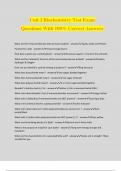
-
Unit 2 Biochemistry Test Exam Questions With 100% Correct Answers
- Exam (elaborations) • 3 pages • 2024
- Available in package deal
-
- £8.48
- + learn more
Unit 2 Biochemistry Test Exam Questions With 100% Correct Answers What are the 3 macromolecules that we have studied? - answerLipids, Carbs and Protein Purpose for carbs - answerPrimary Energy Source How does a plant use a carbohydrate? - answerStructural support - Found in the cell walls What are the 3 elements found in all the macromolecules we studied? - answerCarbon, Hydrogen & Oxygen How can you identify a carb by looking at a picture? - answerRing Structure What does disaccharide m...

Study stress? For sellers on Stuvia, these are actually golden times. KA-CHING! Earn from your revision notes too and start uploading now. Discover all about earning on Stuvia


